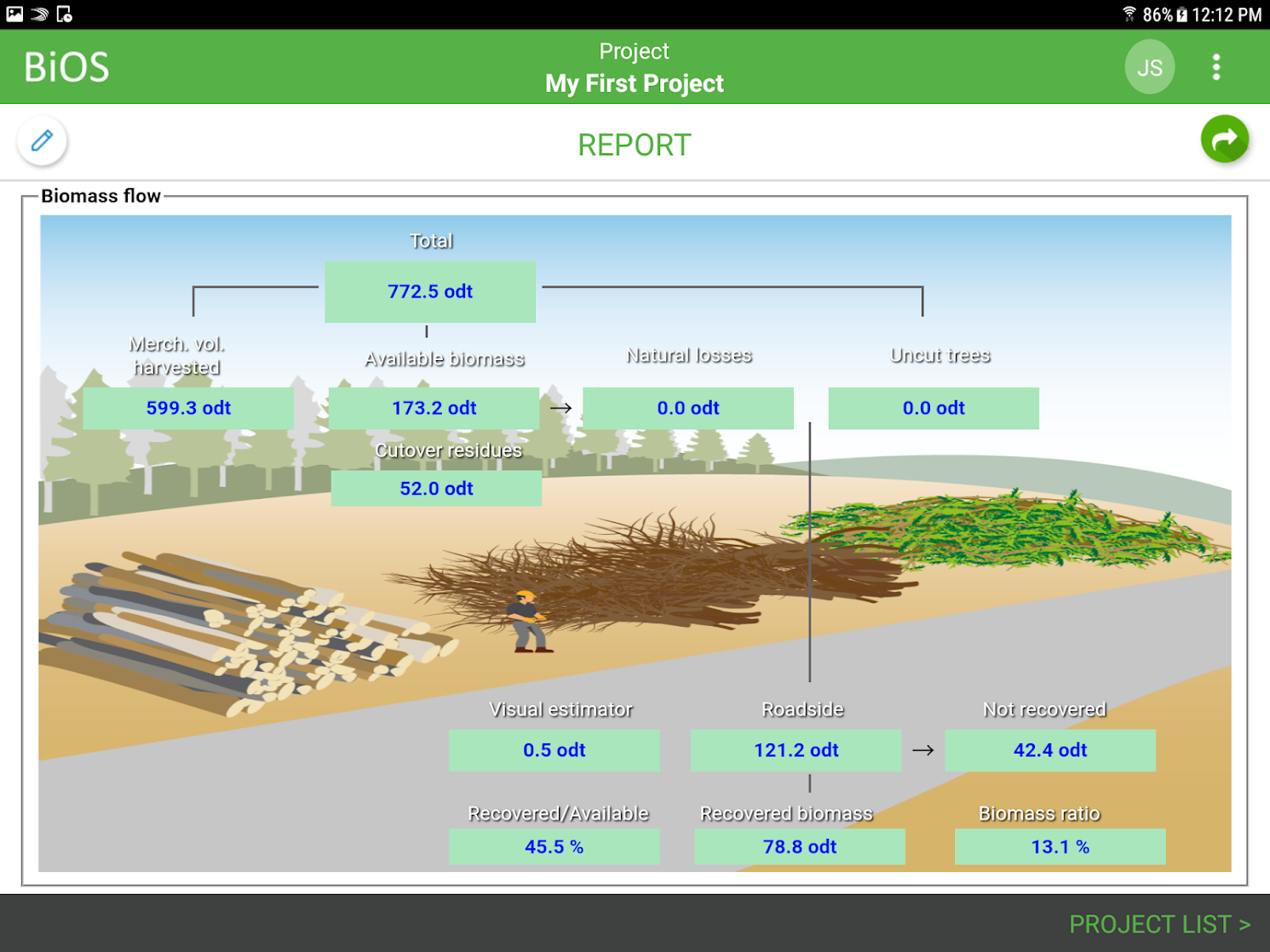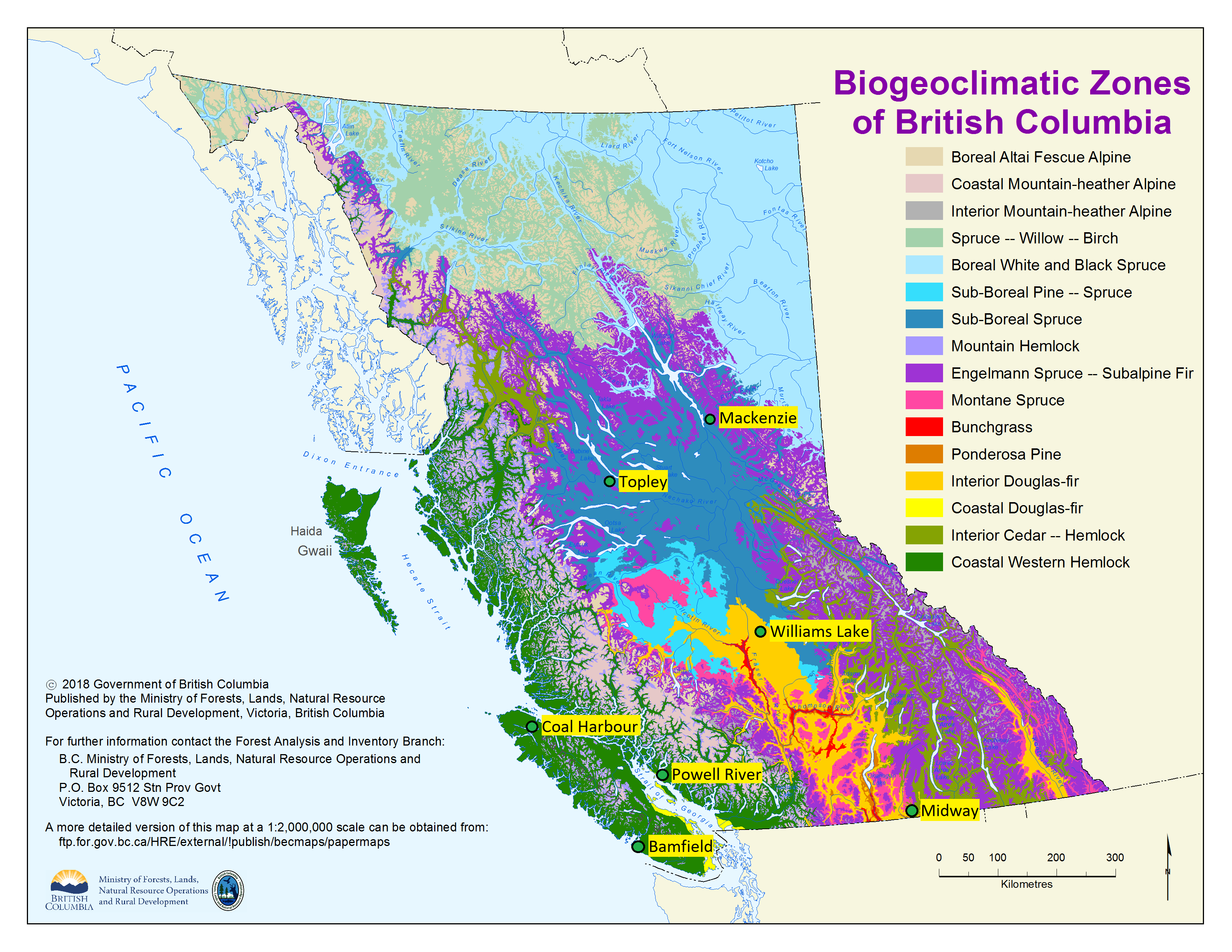Biomass supply analysis
Sustainable development of the local forest bioeconomy in B.C. will depend on accurate information about the cost and availability of residual forest biomass. Advancements in technology in forest biomass tracking and monitoring would improve sustainable management of this resource.
On this page
- Forest Biomass Supply Information System (FBSIS)
- Timber supply area forest biomass analysis
- BiOS app model
- BiOS app validations
Forest Biomass Supply Information System (FBSIS)
The Ministry of Forests, with FPInnovations, is developing an interactive information mapping system, the Forest Biomass Supply Information System (FBSIS).
For access to FBSIS, please contact Catherine Nutting.
This system will provide users with an accurate and timely estimate on both the amount and cost of available residual forest biomass across the province. FBSIS uses three main components:
- The BiOS app
- FPInterface
- Forest BioGIS.
The FBSIS is being developed on GeoBC, which creates and manages geospatial information to inform natural resource management in B.C.
Using forest biomass supply data and analytical tools, the FBSIS will facilitate evidence-informed decision making. It will enhance regional economic development, job growth, Indigenous community engagement, climate change mitigation and adaptation, and wildfire management.
Timber supply area forest biomass analysis
To effectively develop the forest bioeconomy in British Columbia, a detailed inventory of economically available biomass is essential. To address this need, the Ministry of Forests, working with FPInnovations, developed a process to calculate residual forest biomass inventories in B.C.’s timber supply areas (TSA). These calculations are based on harvest and road network plans for Crown land, excluding Woodlot Licenses, Tree Farm Licenses, Community Forest Agreements and First Nations tenures.
FPInterface is an analytical tool used to conduct TSA residual forest biomass analysis. It contains forest productivity data and is used to estimate the cost of forestry activities. This data combined with harvesting and inventory projections allows for a biomass inventory graded by cost of delivery. FPInterface differs from most models which use averages to calculate both cost and amount of residual forest biomass. It accumulates the value of individual cut blocks on the landscape and calculates cost and time to a specified delivery point, such as a sawmill or pulp mill. These analyses provide carbon impact assessments which further inform bioeconomy development and climate action.
TSA residual forest biomass analyses differ from the timber supply review process, which determine the condition and growth rates of a forest, and inform allowable annual cut decisions.
Biomass inventories for the following TSAs have been conducted, while others are still under consideration or development.
- 100 Mile House TSA, 2020 (PDF, 2.8MB)
- Arrow, Boundary and Kootenay Lake TSA, 2020 (PDF, 3.1MB)
- Arrowsmith TSA, 2018 (PDF, 1.9MB)
- Bulkley TSA, 2018 (PDF, 3.1MB)
- Cascadia TSA, 2021 (PDF, 1.2MB)
- Cranbrook TSA, 2020 (PDF, 1MB)
- Dawson Creek TSA, 2020 (PDF, 1.5MB)
- Fort Nelson TSA, 2021 (PDF, 1.2MB)
- Fort St. John TSA, 2020 (PDF, 1.8MB)
- Fraser TSA, 2018 (PDF, 3.1MB)
- Haida Gwai TSA , 2021 (PDF, 771.3KB)
- Invermere TSA, 2020 (PDF, 911KB)
- Kamloops TSA 2018 (PDF, 3MB)
- Lakes TSA, 2018 (PDF, 2MB)
- Lillooet TSA, 2023 (PDF, 2.6MB)
- Mackenzie TSA, 2018 (PDF, 2.2MB)
- Morice TSA, 2020 (PDF, 1.1MB)
- NorthIsland TSA, 2023 (PDF, 2.9MB)
- Okanagan TSA, 2023 (PDF, 2.2MB)
- Pacific TSA, 2021 (PDF, 1.2MB)
- Prince George TSA, 2018 (PDF, 1.9MB)
- Quesnel TSA, 2018 (PDF, 2.5MB)
- Strathcona TSA, 2018 (PDF, 1.8MB)
- Williams Lake TSA, 2018 (PDF. 1.8MB)
BiOS app model
The Biomass utilization mobile app (BiOS) assesses roadside biomass volumes and potential greenhouse gas benefits in real time. BiOS supports evidence-informed decision making, allowing for improved economic development, Indigenous engagement and climate action.
FPInterface assesses harvested residual piles at the individual cut-block level using real-time post-harvest data (e.g. species composition, volume per hectare, topping diameter, logging activities, and distance to a specified destination). This data provides users with an estimate of both cost and available quantities of forest residual biomass, without requiring complex data inputs.

Figure 1. A schematic report created by BiOS app for the breakdown of residual fibre in a cutblock
The BiOS app is one component of the B.C. Forest Biomass Supply Information System (FBSIS) that integrates a user-friendly mobile platform to provide real-time data to further inform forest management and forest biomass utilization through the production of value-added bioproducts.
The BiOS app is free and available for download on mobile devices on iTunes or Google Play. A series of step-by-step tutorials on how to begin using the BiOS app can be accessed on YouTube. A transcript of the video can be found here (PDF, 2.5MB).
BiOS app validations
To date, six field validation trials have been conducted in B.C. to validate and improve the performance of the BiOS model for fibre supply and recovery analysis. The results from the above field validations showed less than 10% deviation between BiOS app predictions and experimental data. A validation study includes:
- Measurement of the biomass flow by assessing the residuals left at the stump and roadside after harvesting operations
- Assessment of the conversion ratio from roundwood (m3) to harvest residues (odt)
- Analysis of the roadside pile volume, pile shape and geometry, along with measurement of pile bulk density on at least ten logging residue piles
Below you can find a summary report and a list of the completed validations:
- Validation summary (PDF, 9.8MB)
- Coal Harbour validation (PDF, 3.5MB)
- Mackenzie validation (PDF, 2.7MB)
- Powell River validation (PDF, 1.7MB)
- Topley validation (PDF, 2.1MB)
- Williams Lake validation (PDF, 1.9MB)
Figure 2: Completed and in-progress field validation trials in BC.

